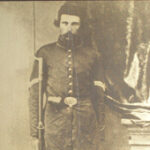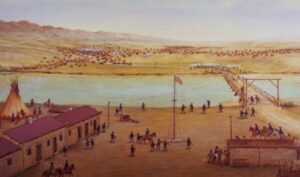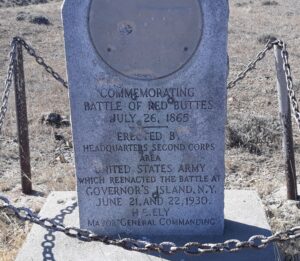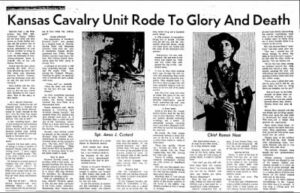
 Everyone has heard of “Custer’s Last Stand,” but what about “Custard’s Last Stand.” Well, it is a real thing. I was shocked when I heard that too. The battle actually had two names. It was known first as the Battle of Red Buttes, and it was fought in 1865, near modern-day Casper between American Indians and US Cavalry soldiers, but it was also known as “Custard’s Last Stand.” It was a small battle, but it was significant too. It directly contributed to the Battle of Little Bighorn, which was also known as “Custer’s Last Stand” and was also the way Casper, Wyoming got its name.
Everyone has heard of “Custer’s Last Stand,” but what about “Custard’s Last Stand.” Well, it is a real thing. I was shocked when I heard that too. The battle actually had two names. It was known first as the Battle of Red Buttes, and it was fought in 1865, near modern-day Casper between American Indians and US Cavalry soldiers, but it was also known as “Custard’s Last Stand.” It was a small battle, but it was significant too. It directly contributed to the Battle of Little Bighorn, which was also known as “Custer’s Last Stand” and was also the way Casper, Wyoming got its name.
Everyone knows about the Battle of Little Bighorn, which is also known as “Custer’s Land Stand” mainly because Lieutenant Colonel George Armstrong Custer, commander of the 7th Cavalry Regiment, was among the 286 US soldiers killed while fighting warriors from the Lakota Sioux, Northern Cheyenne and Arapaho tribes. Well, “Custard’s Last Stand” was also named after a man who was killed in the battle. Following the American Civil War, which wrapped up in the summer of 1865, another war was beginning in the American West. The brutal path that led to the Battle of Red Buttes started the previous winter with the Sand Creek Massacre in southeastern Colorado. On November 28, 1864, Colonel John Chivington and 675 soldiers in the 3rd Colorado Cavalry descended on a Cheyenne and Arapaho village and killed at least 135 people, mostly women and children. These massacres were the catalyst that often sparked these Indian wars. Like the rest, “The massacre united the Lakota, Cheyenne and Arapaho to get revenge for what had happened,” according to Rick Young, manager of the Fort Caspar Museum in Casper.
Emotions were out of control in the summer of 1865. The Indians were attacking and killing settlers all across Wyoming and Colorado. A soldier from Platte Bridge Station, 20-year-old 2nd Lieutenant Caspar W Collins of Ohio, was ordered to meet Commissary Sergeant Amos Custard and the supply wagons. Soon after Collins left the fort that morning with 25 men of the 11th Kansas, they were attacked by as many as 1,000 Cheyenne, Lakota, and Arapaho warriors. Collins and five other soldiers were killed in what would become known as the Battle of Platte Bridge and would thus give Casper, Wyoming its name, in an unfortunate misspelling. The survivors retreated to the fort while Sergeant Custard and his wagons bravely continued their approach.
Unfortunately, the Indians were not yet done with the soldiers. As they approached the fort, the soldiers inside fired a cannon as a warning of warriors in the area. Of course, the warriors could also see the wagons and headed out to attack. Sergeant Custard circled the wagons, and the 11th Kansas Volunteer Cavalry prepared to stand against the attack. The 25 men fought bravely, but they were outnumbered. Their stand failed, and the 
 22 men with the wagons were killed, including Custard. Only three men escaped and reached safety at Platte Bridge Station. That was a horrific day, and in the end, 29 US soldiers and at least eight Native American warriors were killed in the Battles of Platte Bridge and Red Buttes. “Custard’s Last Stand” would later spur “Custer’s Last Stand” as the soldiers went after the Indians who had been the cause of so much bloodshed.
22 men with the wagons were killed, including Custard. Only three men escaped and reached safety at Platte Bridge Station. That was a horrific day, and in the end, 29 US soldiers and at least eight Native American warriors were killed in the Battles of Platte Bridge and Red Buttes. “Custard’s Last Stand” would later spur “Custer’s Last Stand” as the soldiers went after the Indians who had been the cause of so much bloodshed.


Leave a Reply